Discussion Forum
Discussion Forum
Up Next
Video Shorts
Featured Story
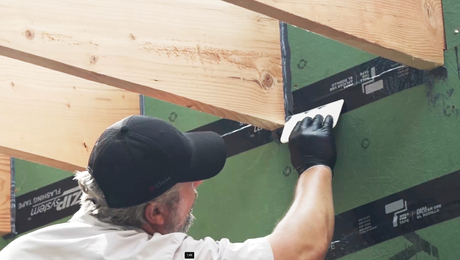
In issue #314, Fine Homebuilding published an article titled “The End of Deep Energy Retrofits” by Rachel White of Byggmeister. The premise was that deep energy retrofits are not as…
Featured Video
How to Install Cable Rail Around Wood-Post CornersHighlights
"I have learned so much thanks to the searchable articles on the FHB website. I can confidently say that I expect to be a life-long subscriber." - M.K.
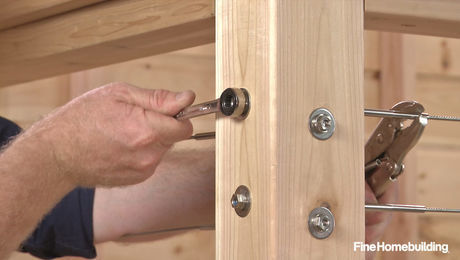


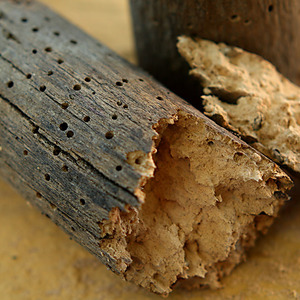
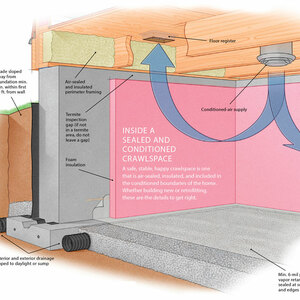






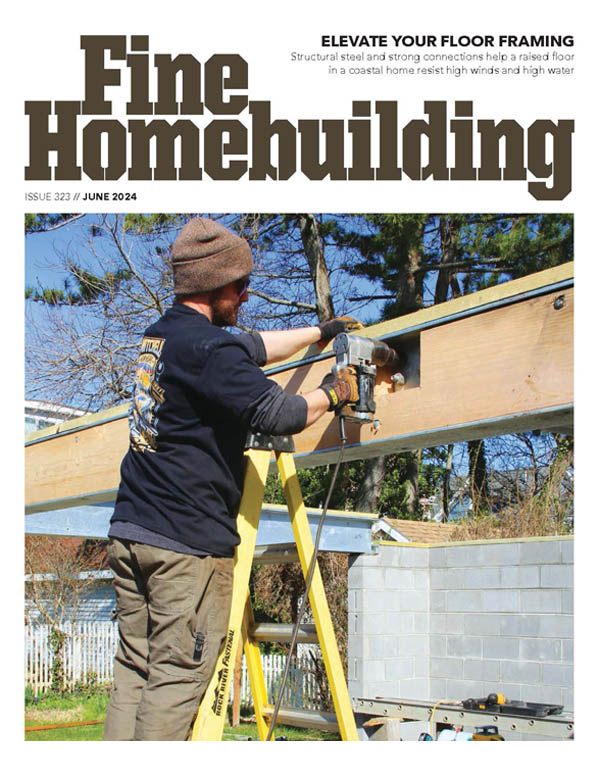

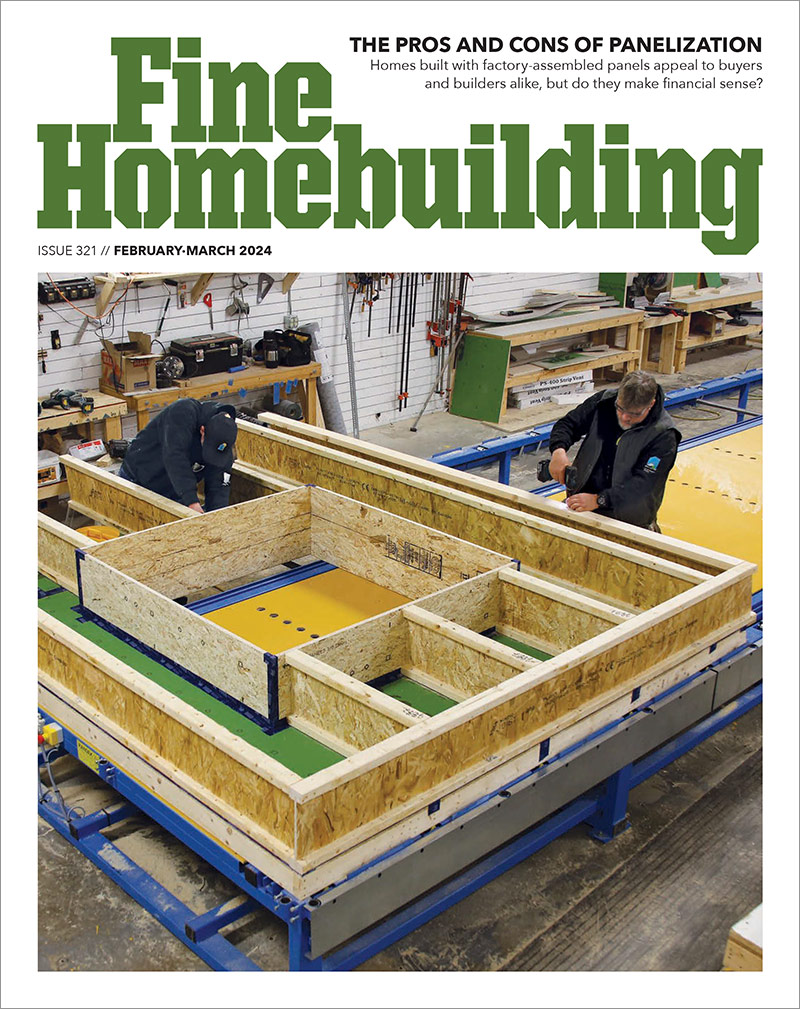

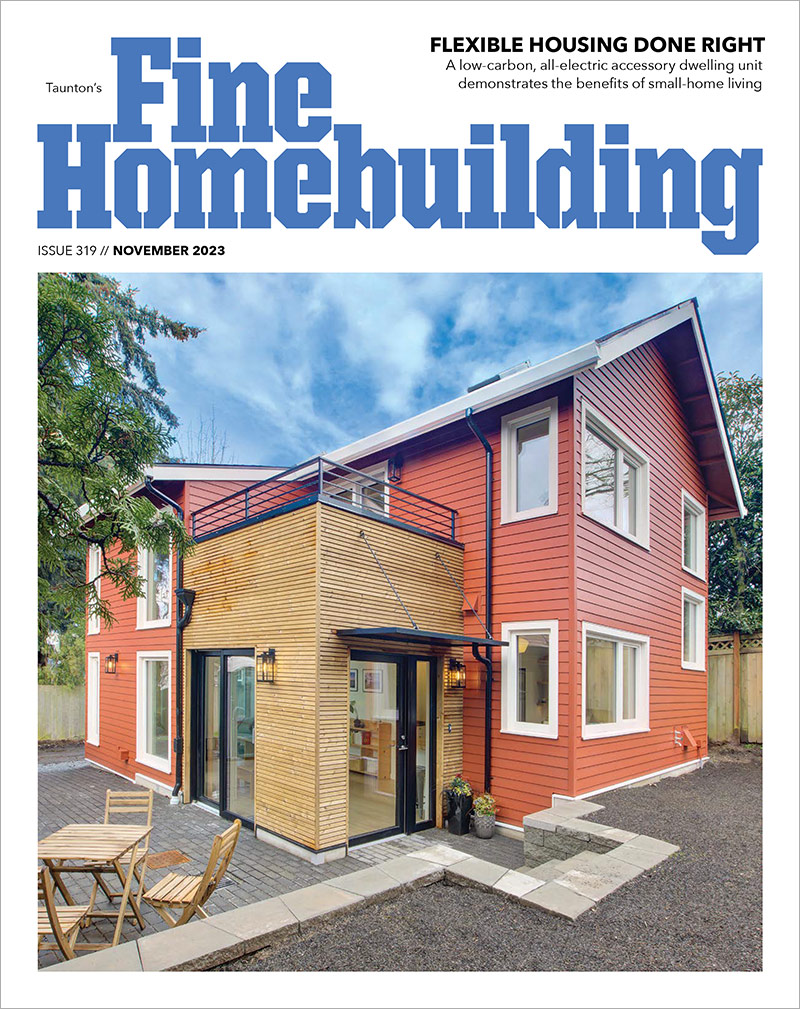

Replies
Thoughts? We should just go ahead and move this thread to the Tavern now, before it gets nasty.
No electrons were harmed in the making of this post.
That's what I'm figuring...but it's also what I am hoping for. I want to see how divided the responses are on this subject.
Justin Fink - FHB Editorial
We had a perfect test model a few years ago. 6 pack of townhouses, great stucco contractor had used felt for 20 years. 1 of the townhouses was purchased by a Dupont exec. who insisted on Tyvek. The result- 5 townhouses with no leaks, 1 townhouse with leaks at several windows.
Building Paper??
Or tar paper?
I don't think anyone uses building paper anymore .
Do a search and you will find lots. But why should I have to tell YOU that?
Eric
It's Never Too Late To Become
What You Might Have Been
[email protected]
I believe the proper term is "builder's felt".--------------
No electrons were harmed in the making of this post.
Rosin paper too.It's Never Too Late To Become
What You Might Have Been
[email protected]
Rosin paper is relatively normal paper, about the consistency of kraft paper, saturated with rosin. Color a kind of translucent reddish tan. A rough approximation of housewrap. Builder's felt or roofing felt is a course paper "felt" saturated with asphalt -- tar paper.
--------------
No electrons were harmed in the making of this post.
Justin said paper, that's why I asked.
This thread should be good and muddied up by now.................It's Never Too Late To Become
What You Might Have Been
[email protected]
Well, "tar paper" is paper.--------------
No electrons were harmed in the making of this post.
Eric,
Building paper is the generic term that encompasses both felt and kraft asphalt impregnated papers.Justin Fink - FHB Editorial
We have used housewrap since I can remember...
However, I would say Felt (aka building paper, tar paper) is a lot cheaper. But, difference in cost may somewhat be may made up in extra labor I am guessing.
I thought I had also read somewhere where in colder climates the felt would be better ? Anyone else heard this...
As far as keeping the structure dry: I think that can be accomplished with both. Like anything else, its how its installed and having proper flashing details.
just my 2 cents.
Working alone, felt is easier to apply than wrap, especially in those 9ft. rolls.
(How come no one has brought up the urban legend about cedar eating tyvek??)
I was wondering the same thing (about the tyvek degradation over cedar)
Also, felt installed by one person is not bad.....never seen anyone attempt to install Tyvek by themselves unless sections were precut on the ground first which wouldnt be a very good way to do it
"Also, felt installed by one person is not bad.....never seen anyone attempt to install Tyvek by themselves unless sections were precut on the ground first which wouldnt be a very good way to do it"I've done it before when I was alone or they didn't have 3' rolls by just cutting the 9' roll in half.Joe Carola
And I'm sure there are tricks of the trade one would learn if one had to apply wrap single-handed very often. To a carpenter of 100 years ago framing a wall laying down would seem like sheer idiocy.(Speaking of which, one way to apply the wrap is to do it before raising the wall.)
--------------
No electrons were harmed in the making of this post.
What about Tyvex exposed over the winter? We are in the last weeks of framing our house and our framer said if we use Tyvex we could side the house at our leisure over the winter and into the spring. Another friend said that if we left the Tyvek up until spring the UV rays will deteriorate the product enough to make it useless? What are people's thoughts? If you can leave it exposed for this amount of time, that would be a benefit over builders paper for us.
Neither product should be expected to perform as new after being exposed for more than about 60 days. The controlling factor is more wind and rain than sunlight.--------------
No electrons were harmed in the making of this post.
The absolute best is Saran wrap, the only one that has a built in cutter hacksaw blade on the box! Geeze..what you guys do to make a job harder amazes me. Spheramid Enterprises Architectural Woodworks
"I don't think it's funny no more" Nick Lowe.
Leaving it up a long time means you will re-do it, or you will need to tie it tightly in place with lathe over it to keep wind buffetting from tearing the stuff around the staples.
Welcome to the Taunton University of Knowledge FHB Campus at Breaktime. where ... Excellence is its own reward!
Tyvek has a UV resistance of 4 months - after that, you want siding to be on. Some other brands can stay exposed for up to a year (according to manufacturers). Don't make the mistake of listening to somebody that says "Tyvek will let you apply siding at your leisure through the winter" when they might really mean to say "Housewraps in general are likely let you apply siding over the course of the winter" - different brands have different UV exposure ratings.
I don't have the UV figures on felt paper, but I'm working to find that out myself.
Justin Fink - FHB Editorial
nice electrons loser, ha ha just kidding, not really
Three other ways to do it alone.One is to staple at the top edge and let'er hang, then climb down and staple the rest. if I have the staging plank at the right level, I can just roll and staple most of it at one pass.Second is to run it vertically if the wall is a tall one, start at the top on the ladder and you can reach about seven feet along the top edge, then let the roll go, pick up on the ground to re-roll and pull tight, then staple off.Thired is top put the Tyvek on before raising the wall.
Welcome to the Taunton University of Knowledge FHB Campus at Breaktime. where ... Excellence is its own reward!
"never seen anyone attempt to install Tyvek by themselves "What am I - something special? All you have to do is start it right with a hammer stapler and roll away
Welcome to the Taunton University of Knowledge FHB Campus at Breaktime. where ... Excellence is its own reward!
Piffin,
You are something special ! :)
I guess I should have been clearer about my statement.
It should have read I have never seen someone go to the trouble of trying to do it themselves.
There, thats better :)
It's not an urban legend! All housewraps lose some water repellency when exposed to tannins and other surfactants. Google Paul Fisette and the Journal of Light Construction to see the research.Andy Engel
Senior editor, Fine Woodworking magazine
Never try to teach a pig to sing. It wastes your time and annoys the pig.
Other people can talk about how to expand the destiny of mankind. I just want to talk about how to fix a motorcycle. I think that what I have to say has more lasting value. --Robert M. Pirsig
None of this matters in geological time.
Would there be any advantage to using rooftop guard II on the walls as well as the roof? Certainly lighter and easier to handle than felt.
If you used "ice guard" rubber membrane on the walls you'd be creating a vapor barrier there. This wouldn't be a good idea for conventional construction north of maybe South Carolina.
--------------
No electrons were harmed in the making of this post.
Not Iceguard, roof top guard II. This is not one of the bituminous membranes.
http://www.rooftopguard.com/"This five-layer polypropylene and polyethylene product has strength, low weight, tear resistance, and long life that absolutely blows away the conventional "old-technology" products."Sounds like a vapor barrier to me. The one saving grace would be that it's only 5 feet wide, so vapor will be able to escape from the seams. But air will be able to infiltrate the same way.--------------
No electrons were harmed in the making of this post.
The principle you cite is valid, but I wonder ifg you know tha tRooftopgaurdII is not the same as I&W shield
Welcome to the Taunton University of Knowledge FHB Campus at Breaktime. where ... Excellence is its own reward!
I feel lkike that is too watertight and unable to breathe and could trap water. But I did use it on this job in photo for areas where water penetration is likely greater.
Welcome to the Taunton University of Knowledge FHB Campus at Breaktime. where ... Excellence is its own reward!
If the house wraps are doing the bulk of your water repelling then you better check out your sidng or your installation techniques. In my opinion, the house wrap should be considered as an exterior wind breaker or possibly the one and only air barrier for the house framed walls, if you've got the techniques down pat. The water repellancy issue should only come into play ocassionally in some of the worst wind driven rain storms and not with every little sprinkle.
There are advanced techniques for leak proof installations of windows in walls with various sidng/finishes and house wraps/papers. A good short article was published in JLC about 8-9 years ago. It uses flexible eave protection like Grace Ice & Water Shield and caulking as well as specific overlapping steps to form the seal. The details were taken from a 200+ page book for installing windows and doors written by architects from Northen Califaornia. Another detail from JLC is a piece of flashing at the bottom of window J-trim. The water that gets in behind the sidng slipped into the J does not exit to the exterior but runs down the building paper/housewrap under the windows. A bit of flashing here will take the water to the bottom hook channel of the siding and off to a joint or to corner trim to be drained. Some of these types of problems are blamed on the new products and not on the installer.
We need a lot of retraining to deal with the changes that we've made in buildings to reduce costs and improve energy efficiency. The gent I replaced as building science lecturer at the local archtitectural school in 2001-2 was away at MIT doing his Phd in building science. His doctoral thesis- window trim and drainage planes/channels!!! So a lot is to be learned.
In our damp wind blown coastal climate (Wilma was here last night), it was considered OK when wood window side jambs, casing/trim and sills rotted after 60-100 years. No caulking was used where wood sidings met wood window trim and cornerboards. The first house I learned on (I essentially bought a 200 year old Cape Cod style post and beam frame and 2 acres for $9,500) did not even have lead/zinc flashing/drip caps over the window head trim- it was moulded/ planed as part of the drip cap with an extension of 1/4" by 3/4" up underneath the siding. 85% of the original wood clapboard is still on the house. These houses stood up well if painted and maintained.
I have seen (1994-6) award winning houses by architects here have severe rot in wood windows/trim and plywood sheathing with pine clapboard/cedar shingles within 6-8 years of completion. (See note below) All of these houses had various wood sidngs and in the odd case even vinyl siding with exterior polystyrene insulation board. and tar paper. But 95%+ had TYVEK. So the problem has been indentified as TYVEK and 10 years later it is still TYVEK to many builders although the real reasons are known and codes have changed to require a "rainscreen" under siding now.
The problem goes like this: our older houses were loose and drafty with heat and air moving through uninsulated unsealed walls and unsealed rough stud openings for windows and doors. If a bit of rain got in behind the window side casing and whatever sidngs that were uncaulked or driven by wind up under sidings, the heat and air movement would soon dry it. This was not good design but pure and simple luck. Over time though some rot would develop...so the system was not perfect.
We now have stopped the bulk of the heat and warm/cold air leakage going through the walls (this is good for comfort and savings, isn't it?) but the heat/air drying drying factor is gone (and we're in a cool damp climate). And we didn't stop all the rain penetration- regular $4-5 caulking develops hairline cracks for water entry quite soon, water can still get blown behind wood based sidings where it soaks into the unpainted back sides of the wood product.........plus the drying factor is not working so rot is speeded up by a factor of about 10: from 60-100 years to 6-10 years.
The solution is not to change the building wrap back to tar paper which only slows the rot down a bit since the tarpaper is slightly less permeable than housewraps. Provide a open drainage layer (the rainsceen) for the water and make sure that the back of wood sidings do not absorb water (acting as a resevopir until the right conditions occur for rot to start.) Paint them with primer or sealer before installation.
We have always used a rainscreen of 3/4-1" space behind brick veneer as it is so leaky. We have flashing and weep/drain holes at the bottom course of brick to drain this water. Now all we have to do is apply this knowledge and a bit more to other systems to have good performance. It's not a tarpaper versus housewraps issue but know the systems you're dealing with and understand that when you make a change to one part of it such as airsealing and high levels of insulation (the good things...yes??) that changes may have to be made in other parts.
Note: Nova Scotia has a "mini British Columbia condo problem of severe rot in certain situations. British Columbia had about 1 billion worth of rot and mould with some retirees /owners virtually going bankrupt and having to walk away from their abodes.
> Phd in building science. His doctoral thesis- window trim and drainage planes/channels!!!
Wow, just amazing. You can get a PhD in window flashing. If I'da known that 40 years ago, I coulda been an intellectual.... ;-)
-- J.S.
Mr. Sprung:
Remember that the California architects wrote a 228 page book on installing windows and doors and the Journal of Light Construction- a well recognized. periodical- felt that at least 4 pages dealing with 2 system for houses were worthy of being reproduced in their magazine.
Canada's two largest contractors now have building scientists on staff to prevent law suits. For each project they build mock-ups of the various important flashing details and take them to the jobsite to show installers the various steps to be taken. SO no reason for not knowing that wasn't the way it was supposed to be done!! It costs a lot of money to start re-installing windows on 10+ storey buildings 2-3 years after they were built. For a while people were afraid to walk by the John Hancock Insurance building in Boston on windy days as sealed glass panes ocassionally popped out and fell many stories to the street.
Some of the building scientists are able to function just like lawyers now- they're the only other ones in the law suit making money!!!
when I see tyvek all I can think about is the cottage we rented in PEI, the wrap was flapping around in the structure somewhere, drove us crazy ..
Also, just want to mention another factor: I've seen many a HO pressure washing their vinyl siding from the ground below. This is probably about the same as a Category 6 hurricane in terms of getting water up under the (yuk) vinyl siding - or any siding for that matter. But why do they have to pressure-wash the siding in the first place? Mold from bad flashing? No rainscreen?
Maybe it was better before was started making houses to "air-tight?" Makes you wonder... Have read several of the other comments about older homes "breathing" and evaporating the water in the wall system. Seems like we have created a whole new set of problems that then require further new solutions and materials - and then they create newer problems.
Or was it when we cheapened materials because of increasing labor costs?
Is there a conspiracy theory in here anywhere?
Truckin' on...
Mould grows on the surface of vinyl siding (and a lot of others) due to organic dusts (pollen, cellulose, etc) providing food for the mould. Condensation and rain provide the needed moisture. Some sides of buildings usually the north or shaded sides where the sun doesn't dry the moisture, may be the worst or only ones with the mould growth.
I don't think we've created a whole new set of problems with airtight, energy efficient buildings. The American Lung Association recommends them for their members (See http://www.healthhouse.org). The older buildings had rain leakage that in most cases we got away with due to empty wall cavities that moved a lot of heat/cold and air through them. But that gave you high energy bills and cool drafty rooms. To stop all rain leakage can't be a bad thing, can it?
A problem with vinyl is that it doesn't "shed" like regular paint. Most exterior paints are "programed" to slowly deteriorate, so that faded pigments wash away, along with mold and dirt. Vinyl, on the other hand, is designed (as much as possible) to NOT slowly deteriorate, since when it deteriorates it fades rather badly.
--------------
No electrons were harmed in the making of this post.
If I'm working alone, I find it easier to install Tyvek, especially with a wind. Must be in the technique
Welcome to the Taunton University of Knowledge FHB Campus at Breaktime. where ... Excellence is its own reward!
Man, I was taught to install 9' or 10' Tyvek by myself. When I was new on the jobsite, the "veteran" showed me how to do it without wrinkles and to this day myself or someone else installs out ahead by themself and it works just fine unless it's really windy :-)
Now we have shear inspections or we would install it while the wall was on the deck. That is always the easiest :-)
For those who like felt, are you using #15 or #30. I've been told that nowadays, #30 is actually 15 pound felt and #15 is actually under 10 pounds. Any thoughts?
I still use #15 because I don't like the way 30# wrinkles
Welcome to the Taunton University of Knowledge FHB Campus at Breaktime. where ... Excellence is its own reward!
The code requires the use of building paper that "weighs not less than 14 pounds per 100 sq. ft." which has traditionally been referred to as "15# felt".
But because manufacturing processes and materials have improved, the old "15# felt" no longer weighs 15-lbs., so it began to sell as "#15 felt" instead (notice the placement of the # sign).
I happen to have some #15 on-hand, and it turns out that a 432 sq.ft. roll weighs 36 lbs. even - that comes out to just over 8-lbs./100 sq. ft.
...so in other words, the code requires 14-lb. minimum, but #15 felt paper will only be about 8-lbs. -
I guess it's a code violation that nobody enforces?
Justin Fink - FHB Editorial
Edited 10/27/2005 10:20 am ET by JFink
Justin,
One way to get the best stuff is to ask for felt with an ASTM 226 rating. THis stuff is generally 12 - 13#/100sf.
Advocate
Thanks Justin, that's a question i've wondered for a long time and now you've answered it. :)
AFAIK, code here never required the use of "building paper" on walls. However, I think recent code requires some sort of housewrap or equivalent, for energy reasons.
--------------
No electrons were harmed in the making of this post.
It might be in your world, but after working in four states, the only way I have ever heard that term used is for rosin paper. Wanna restate the question and either defione the terms or use words we all understand?
Welcome to the Taunton University of Knowledge FHB Campus at Breaktime. where ... Excellence is its own reward!
I will restate the question for everybody again, using common terms...
Which do you use:
Housewrap (ie: Tyvek, Typar, or any other plastic-based weather-resistive barrier)
or
Building Paper (ie: #15 felt, asphalt-impregnated kraft, tar paper, roof felt, etc)
...and more importantly - why?Justin Fink - FHB Editorial
There's another product I've seen advertised, but couldn't find again with Google. It's a paint-on substitute for housewrap. You spray it on right over the structural sheathing. Only comes in bright yellow. Does anybody know about this stuff?
-- J.S.
how would you tuck the window head flashing under it?
Welcome to the Taunton University of Knowledge FHB Campus at Breaktime. where ... Excellence is its own reward!
> how would you tuck the window head flashing under it?
That I don't know. I've only seen a magazine ad for it, and wondered if anybody had any experience with it.
-- J.S.
Thanks for that. We can't let you wordsmiths get too sloppy with the language. You have a higher standard than the rest of us word ( wood) butchers
Welcome to the Taunton University of Knowledge FHB Campus at Breaktime. where ... Excellence is its own reward!
Here's my two cents worth - In remodeling our old farmhouse (back in the 1970's) we came across reddish rosin paper with handwritten notes from 1909. It was a bit crumbly under pine siding, but still shed water.
Have used my share of "tar paper" under both wood siding (yes, Virginia, some of us hate plastics, ie vinyl siding, for a whole variety of reasons)and roofing materials, and respect it a lot. It will certainly last through the winter and not deteriorate rapidly from sunlight/UV. On the other hand, you usually only put up a 3' wide section at a time, so you can see where your nails should go; you don't "wrap" a house in it. Have uncovered tarpaper in remodeling many years later, and it was in great condition. Subject to wind-ripping if you don't get the siding on before the wind takes over. Tyvek et al seem to withstand winds fairly well. Penetrations through any covering need to be treated with care, particularly at lower corners.
"Think like a rain-drop" is what my old friend Earl Hartpence used to say. Then build accordingly.
Maybe that's three cents worth, but I'm going to bed. Night all!
Helped my Uncle take the old (82 yr) fir siding off his house's southern side. We were to put up cedar siding that he had molded to the same contour as the old fir. The other sides of the house were fine but it was obvious the fir on the south side was giving it up after all those years in Puget Sound weather.
There was tar-paper underneath that looked pretty good considering it was applied in 1916 (we found a brass tag with the builders name and date on it) Some water streaks but nothing too serious and more importantly, no rot.
Being a HO he asked my opinion on tar-paper v housewrap. I didn't feel like I had an informed opinion because my experience up to that time was with older restorations. I told him I would ask around. We used tar-paper doing Victorian restorations in SF but that was due to other considerations.
I came back by the next week and he was stapling tar-paper to the side. I asked him why and he said he did a lot of research and found all the pros and cons but what made the decision for him was when he found out that the president of the National HouseWrap Assc. had his own house re-sided with tar-paper underneath. Didn't check his story but he is a pretty thorough type of guy.
Since then we have used tar-paper unless spec'd otherwise. No callbacks so far.
Hope this helps.
Terence
ps I think the advice to "think like a raindrop" is well taken.
Terence
Two good things about the housewraps we have used. Fast application, meaning less labor, and if you have used sheathing with the factory-inked framing centerlines, they can be readily seen right through the wrap when it comes to applying siding and trim.
Since it costs more, you are paying for those two conveniences.
I would be skeptical of claims that wraps leak and felt doesn't, or vice-versa. Those leaks are coming from penetrations or bad joints somewhere, and not through some non-penetrated or center area of material.
The siding I tear off to replace froma hundred years ago had pink building paper under it. it has water staind and nail holes.
Nowdays, we use Tyvek, tarpaper, or Green gausrd, depending on the situation
Welcome to the
Taunton University of Knowledge FHB Campus at Breaktime.
where ...
Excellence is its own reward!
Yeah, the pink paper is rosin paper, more or less. It was used primarily as a wind barrier. It did little to prevent water penetration.Useta be that the siding was supposed to prevent water penetration.
--------------
No electrons were harmed in the making of this post.
"Useta be that the siding was supposed to prevent water penetration."I don't know if you belive that or were just parroting from of olde...I have never removed old siding for replacement without seeing water signs behind it, so I doubt there was ever a time when siding was a totally water resistant surface. If anyone ever believed it was, they were into mythology
Welcome to the Taunton University of Knowledge FHB Campus at Breaktime. where ... Excellence is its own reward!
When I pulled the old hardboard siding off of our house (about 18 years old) there were only a few minor water stains on the sheathing. And that was poorly-installed siding, poorly caulked.--------------
No electrons were harmed in the making of this post.
I don't conside 18 to be an old house. Sixty or eighty maybe would be an old house. Why in the world would you want to remove siding that is only 18yO?
Welcome to the Taunton University of Knowledge FHB Campus at Breaktime. where ... Excellence is its own reward!
> I don't conside 18 to be an old house. Sixty or eighty maybe would be
> an old house. Why in the world would you want to remove siding that is
> only 18yO?Like I said, we removed the hardboard siding.
--------------
No electrons were harmed in the making of this post.
Aha! The masonite problem
Welcome to the Taunton University of Knowledge FHB Campus at Breaktime. where ... Excellence is its own reward!
and what is the bulletized criteria for each situation Piffin?Justin Fink - FHB Editorial
bulletized must be one of those editorializers words;)most of the time, we use Tyvek up until last year or so. That is when rainscreen data became more widespread and we started using Rain slicker over the Tyvek. ( long time ago, we used 3/8" lathe over tarpaper for rainscreens) Thew crews felt like the Rainslicker while a good idea, was too time consuming to install and fine control was needed to keep from nailing calpboards too tight and giving uneven look to the surface.This year, we went to GreenGaurd tocahnnel that moisture down and out. This product is wovenm to grant minor droplets a path to follow while still being able to breathe and to resist most moisture passing through. It is heavier than Tyvek and more expensive, but probaly worth it, far cheaper than Rainslicker. At this point, I would continue using it for any quality home. An economy home would get Tyvek and <ugh> vinyl sidingFor garages and shed, tarpaper
Also, given all we have heard about tannins, I would use tarpaper again under cedar shingles.OIoops, I forgot the bullets. paragraphs Ok?
Welcome to the Taunton University of Knowledge FHB Campus at Breaktime. where ... Excellence is its own reward!
Piff,
Have you seen any of the same problems with GreenGuard that you found with Rainslicker (or Homeslicker)? ie: shakes that crack when you try to nail them to such a spongy surface, or the wavy look that you describe in clapboards?
Justin Fink - FHB Editorial
No, the green Gaurd gives us a nice firm surface undeer the siding. The only thing to watch out for is that it is directional, the cords woven in to provide a drainage system must be run verticaly
Welcome to the Taunton University of Knowledge FHB Campus at Breaktime. where ... Excellence is its own reward!